
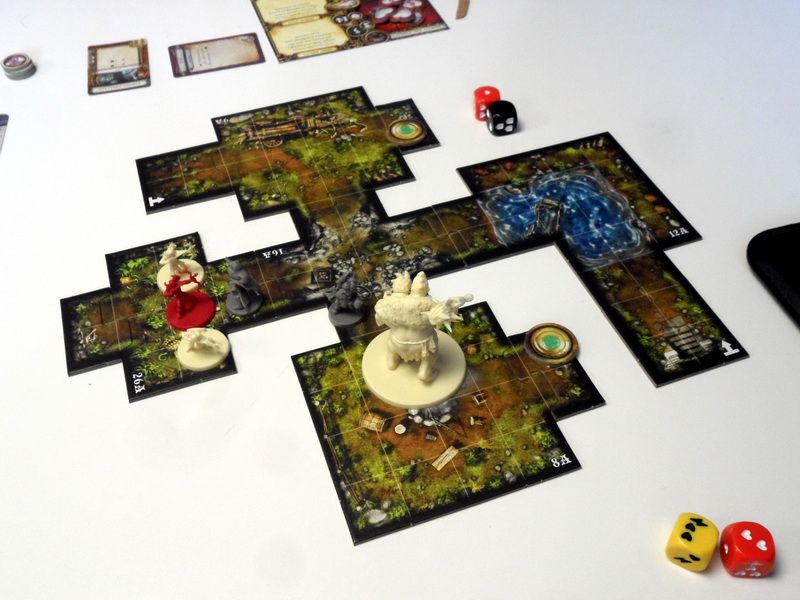 In this third and final article about Descent 2nd edition I will talk about the gameplay and how it all flows, basically the "real review".
In this third and final article about Descent 2nd edition I will talk about the gameplay and how it all flows, basically the "real review". Descent is a Dungeon crawling type of game that involves 2-4 hero characters playing co-operatively against 1 player who is the "Overlord" (the games Dungeon master). The heroes always have some quest they need to complete, the job of the Overlord is to provide real intelligence to the actions of the monsters as opposed to games where you play against an AI controlled dungeon. The game always follow the same turn structure, of heroes going first and doing their stuff - then the second half of the turn is the Overlord activating his minions and playing Overlord cards (well Overlord cards can be played in the heroes turn as well.
Descent is a Dungeon crawling type of game that involves 2-4 hero characters playing co-operatively against 1 player who is the "Overlord" (the games Dungeon master). The heroes always have some quest they need to complete, the job of the Overlord is to provide real intelligence to the actions of the monsters as opposed to games where you play against an AI controlled dungeon. The game always follow the same turn structure, of heroes going first and doing their stuff - then the second half of the turn is the Overlord activating his minions and playing Overlord cards (well Overlord cards can be played in the heroes turn as well.
 From what I've seen quests are generally not "time limited" to a set number of turns, but there is often no reason for the heroes to stall. This also doesn't mean that you have to make an idiot rush. Of all the "dungeon crawling" type kind of games that I have played I enjoy this game the most, the general idea and overall mechanics appeal to me a lot more than the other games of similar theme that I own.
From what I've seen quests are generally not "time limited" to a set number of turns, but there is often no reason for the heroes to stall. This also doesn't mean that you have to make an idiot rush. Of all the "dungeon crawling" type kind of games that I have played I enjoy this game the most, the general idea and overall mechanics appeal to me a lot more than the other games of similar theme that I own.First of all, your heroes can pick a class, while there are only 2 classes, the additional skills and weapons combined with your basic character archetype leans towards a much more interesting long term campaign experience. It does feel just like a real RPG when you accumulate experience points and spend them in between quests to upgrade your skills. Likewise, just as the heroes become more powerful, halfway through the campaign all monsters become "act
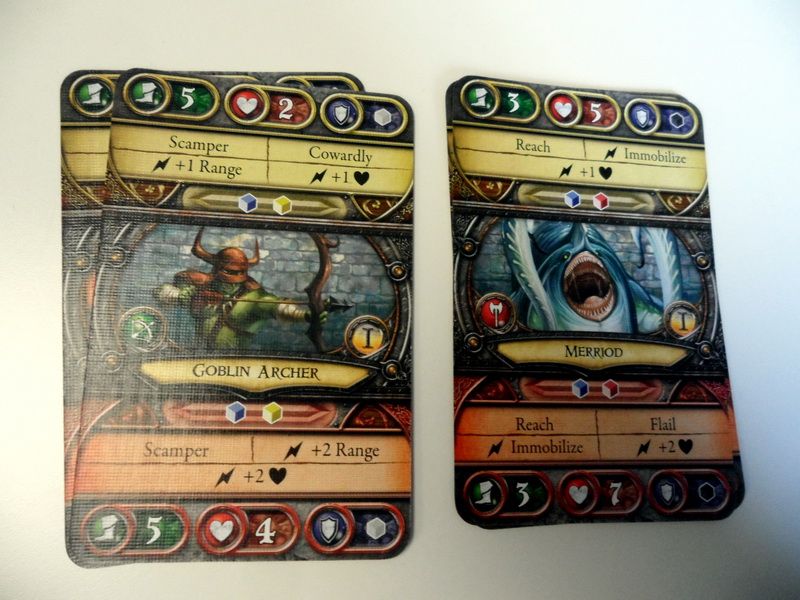 II" monsters which means they get tougher and get a boost on their special attacks. The player acting as the Overlord also isn't left behind as is able to improve his hand of Overlord cards with special Overlord cards that are obtained by spending Overlord experience points (received for defeating the heroes in a quest).
II" monsters which means they get tougher and get a boost on their special attacks. The player acting as the Overlord also isn't left behind as is able to improve his hand of Overlord cards with special Overlord cards that are obtained by spending Overlord experience points (received for defeating the heroes in a quest).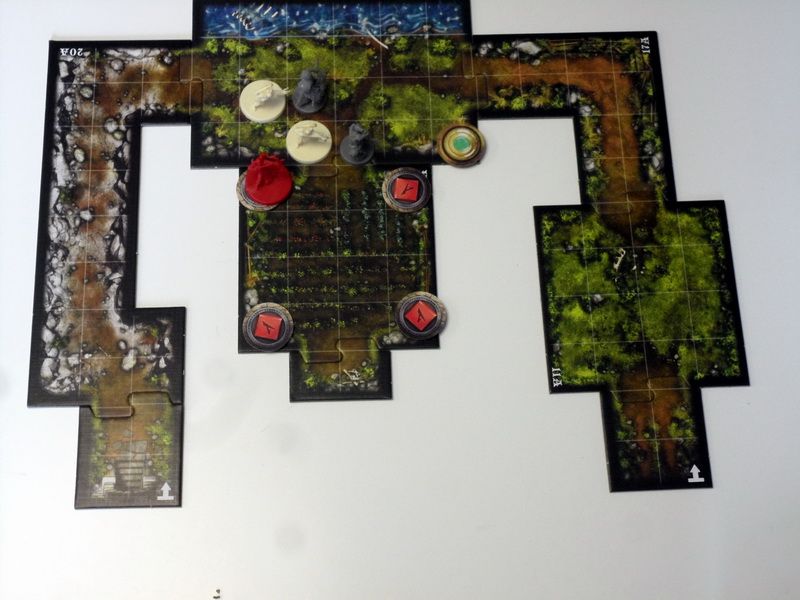 I like this dynamic leveling of heroes and bad guys. The amount of monsters is also determined by the amount of heroes, so the game scales itself appropriately as well - so it is very much possible to play the game just as good with 2 heroes as it is with 3-4. I also like that the Overlord is somewhat limited to what monsters he can use in each scenario, otherwise you would be able to power game the hell out of each scenario by always choosing the best monster types. Now each scenario have an environmental limitation, which together with the "locked" monsters in each category make a bit more sense most of the time.
I like this dynamic leveling of heroes and bad guys. The amount of monsters is also determined by the amount of heroes, so the game scales itself appropriately as well - so it is very much possible to play the game just as good with 2 heroes as it is with 3-4. I also like that the Overlord is somewhat limited to what monsters he can use in each scenario, otherwise you would be able to power game the hell out of each scenario by always choosing the best monster types. Now each scenario have an environmental limitation, which together with the "locked" monsters in each category make a bit more sense most of the time. I'll need to talk more about the Overlord and hero gameplay mentality. I've played this game as the Overlord against 2 and 3 heroes so far. In both cases it has come down to a bit more mental energy being put into thinking about the best approach and in some cases retreating back to a more favorable position to limit how much damage the heroes can make on your monster, or the heroes falling back to heal themselves. As the Overlord your job is often to stall the heroes to pull off your task, while the heroes have their own quest to accomplish. For instance, in the first quest "The Fat Goblin" the Overlord player has to stall the players as he is interrogating captured villagers, the Overlord cannot win until he finds the specific villager he is after, at which point the Overlord has to make sure that prisoner is dragged past the heroes and escape. The Heroes have to simply kill the boss handling the interrogation (and being responsible for all the kidnappings) as well as prevent the enemy boss to escape with the specific villager if he becomes revealed.
It's a simple premise, but it also makes for a slightly more interesting game where both the heroes and the Overlord have some active goal rather than just "fighting every monster". The Overlord sometimes get reinforcements, and sometimes he just has the monsters that start on the board, in which case he have to think how to use them most efficiently instead of just rushing the heroes with great enthusiasm.
The Overlord is also aided by his Overlord deck, the 15 basic cards are a mixed bag of dirty tricks. On top of that the Overlord may spend experience to expand his hand further with special and nastier effect cards that can be played to disrupt the progress of the good guys. Here the Overlord too can choose to specialize himself, either by starting a skill tree of Warlord/Saboteur/Magus where each "class" involves cards which are a bit more specialized thematically. Or he can pick the general Overlord cards that are cheaper but not as awesome as the specialist route.

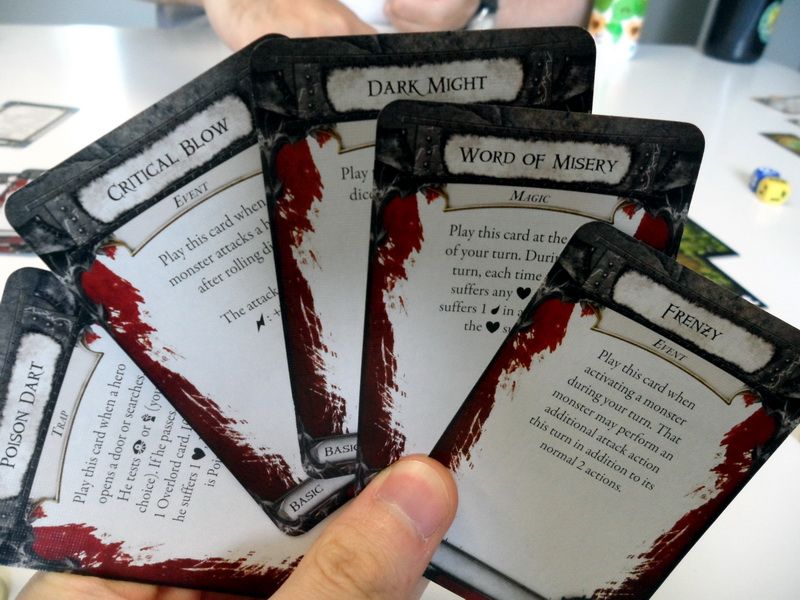
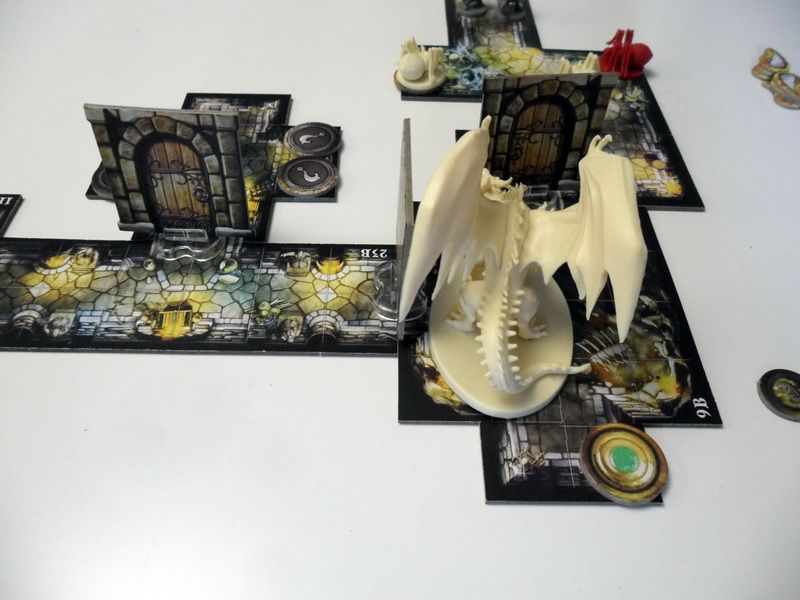
 Combat and resolving events or testing attributes is all done by rolling dice. A monster that has an attack of 1 blue and 1 yellow dice roll those two together when attacking. A hero may have 1 grey die to defend with, and rolls that to negate any damage. Combat rolls combine "Critical fail", "surge", "damage" and "range of a ranged attack". Critical fail means that the whole attack failed and the opponent doesn't have to roll any defensive roll. A "surge" is a special attack or skill that is triggered whenever a flash symbol is rolled. Monsters often have at least one, master monsters and heroes have at least 2 linked to their character or weapons. For every "surge" you roll you are allowed to use 1 special ability. To use a surge you are very often required to deal at least 1 point of damage before adding any additional surge effect. A zombie that had "Disease" as his surge can roll a flash symbol and 1 damage, if the hero also rolls 1 shield and blocks that point of damage the disease effect does not come into play.
Combat and resolving events or testing attributes is all done by rolling dice. A monster that has an attack of 1 blue and 1 yellow dice roll those two together when attacking. A hero may have 1 grey die to defend with, and rolls that to negate any damage. Combat rolls combine "Critical fail", "surge", "damage" and "range of a ranged attack". Critical fail means that the whole attack failed and the opponent doesn't have to roll any defensive roll. A "surge" is a special attack or skill that is triggered whenever a flash symbol is rolled. Monsters often have at least one, master monsters and heroes have at least 2 linked to their character or weapons. For every "surge" you roll you are allowed to use 1 special ability. To use a surge you are very often required to deal at least 1 point of damage before adding any additional surge effect. A zombie that had "Disease" as his surge can roll a flash symbol and 1 damage, if the hero also rolls 1 shield and blocks that point of damage the disease effect does not come into play. It's a fairly straight forward system, and I think it works really well. Dice are also used for other things, you test attributes by rolling 1 grey and 1 black defensive die, the goal is to roll equal to or lower than your testing attribute in order to succeed. All heroes are good at different things, obviously, thus it makes sense to send the Dwarf in front of everyone else as he is able to shrug of any disease effects a lot easier than your mage. This is also the reason why I think each player should have a character of a different archetype when playing instead of running 2 fighters and 2 rouges.
It's a fairly straight forward system, and I think it works really well. Dice are also used for other things, you test attributes by rolling 1 grey and 1 black defensive die, the goal is to roll equal to or lower than your testing attribute in order to succeed. All heroes are good at different things, obviously, thus it makes sense to send the Dwarf in front of everyone else as he is able to shrug of any disease effects a lot easier than your mage. This is also the reason why I think each player should have a character of a different archetype when playing instead of running 2 fighters and 2 rouges.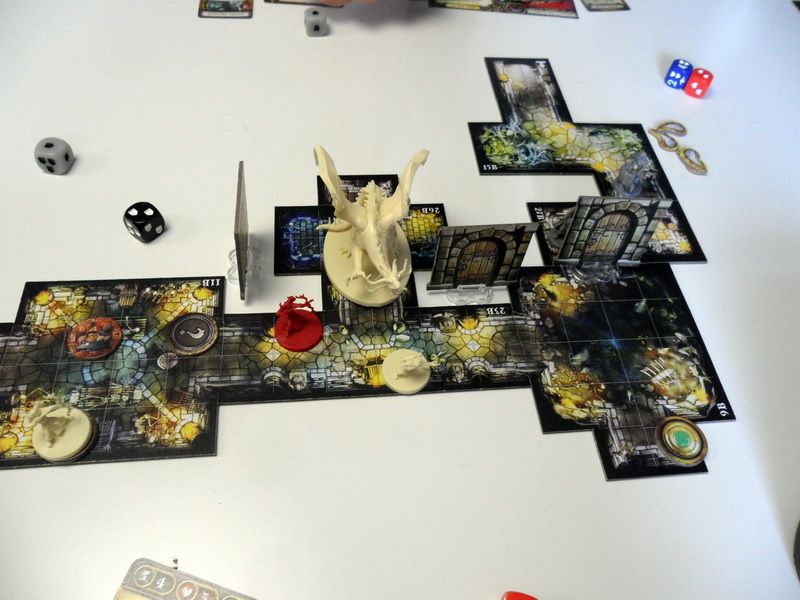 Moving on.
Moving on.As mentioned earlier in the review the game has heroes activate first and then the dungeon master reacts with his monsters. Overlord cards can always be played at any time as described on the cards. The Overlord draws 1 card for each hero at the start of the game, and then 1 additional card each turn. The Overlord can save this cards, and they do carry over from Encounter 1 to Encounter 2 of a quest. He can also choose to play several cards during a single turn, there is no limit to how many cards can be played as long as the rules on the cards allow it. This means that you can boost a single monster with several cards, but not use duplicate cards on the same monster. When an Overlord card is play it is discarded from the hand and thrown in the discard pile. Once the Overlord has worked through the whole deck of his available cards, he shuffles them and starts over from the top. So the Overlord never runs out of cards, but may do well in saving cards instead of playing 1 card each turn. Because the heroes aren't stupid and the monsters themselves cannot handle them alone, it is up to the Overlord to boost his available force with the right combinations at the right time, this also means that the Overlord needs to play smart with that he has.
And while each hero have 2 action that can be used on all sorts of things, including 2 attacks, the monsters the Overlord controls are limited to but 1 attack per turn, which again, may force the Overlord to think about tactics.
There is one huge thing in this game that I have never encountered before and which really have to be mentioned. You cannot die in this game. Heroes reduced to 0 health are temporarily knocked out. This may sound awful but considering the combinations the Overlord could potentially throw at the heroes I think this has worked quite well in the games that I have played. Let me explain this further.
Let's say a Hero starts out with 10 health, there are very little skills the heroes have that can heal the group. There is a chance you will find health potions in your current quest, but at the end of the day - what you start with in terms of health points is all you have. And more importantly, the damage you suffered in Encounter 1 carries over to Encounter 2 of the quest. If the heroes could die permanently I think the game would be insanely hard even if played very well by the heroes. I'm not suggesting that the heroes now die a lot, usually a single weakling character gets sniped by goblin archers or something like that. What happens when you drop to 0 health is that your model is replaced with a token. This means that the space you previously occupied counts as empty, and enemy models can move through you. A knocked out hero also suffers full "fatigue" so you won't be able to perform a lot of special attacks without losing further health unless you spend your turn on resting after getting revived.
Getting revived happens in two ways. Either the knocked out hero spends both of his action to stand back up, doing so the player rolls 2 red dice and recovers the amount of generated hearts. So you are never brought back more than above bare minimum and will be easily knocked out again. The other option is for another character in base contact with your token to revive you spending 1 of their actions on this task. This works the same way with 2 red dice worth of health brought back.
While you are knocked out, and especially if all heroes somehow end up knocked out and separated from each other, you will have a really hard time getting back into the game if the overlord has monsters to cover each hero for continuous bashing.
So there's that. And speaking of fatigue, you can either spend your turn on resting and recover all lost fatigue, or recover 1 fatigue for each "surge" you don't use when making an attack roll. The mechanics for fatigue works really well, excessive fatigue leads to your character taking damage. And I also think it simulates well enough the tiring aspects of combat your heroes have to endure. It also limits the heroes from using all their special powers and skills each turn.
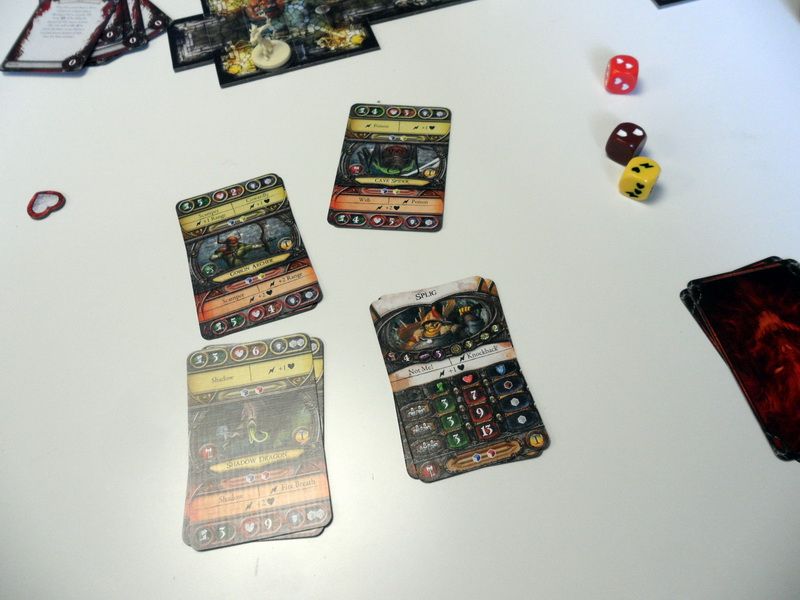
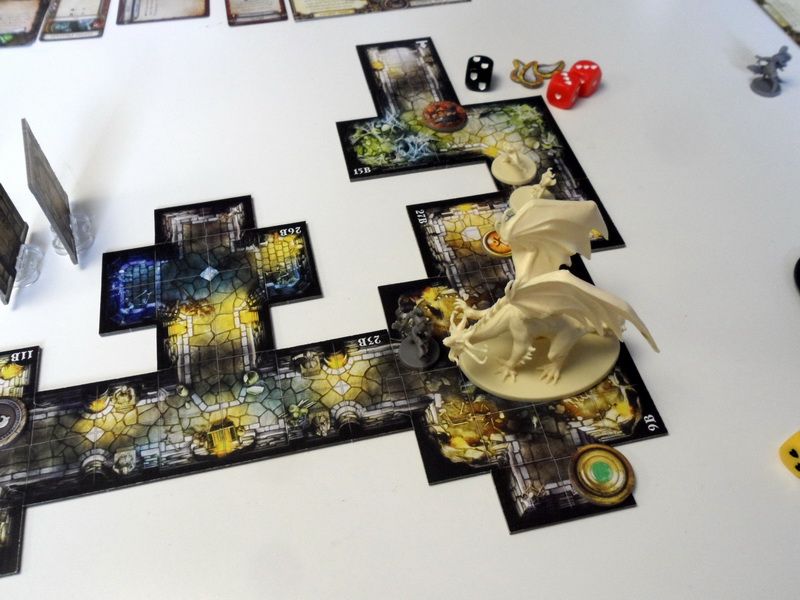 Experience is only earned for completing quests. So no monster grinding. The winner of a quest may benefit from additional experience points, heroes that win a quest also often receive a monetary reward which can be spent in Arhynn (the starting town) to which the heroes return in between quests. Arhynn has a shop made up of two shop decks, one for each Act of the campaign. Items are generally cheaper and weaker in the Act I shop, while more expensive and powerful in the Act 2 shop. As players share a common stash of gold they can always discuss what to buy. Items can be swapped between characters during the game so you can always pass along your old items to another player if you get a new better item.
Experience is only earned for completing quests. So no monster grinding. The winner of a quest may benefit from additional experience points, heroes that win a quest also often receive a monetary reward which can be spent in Arhynn (the starting town) to which the heroes return in between quests. Arhynn has a shop made up of two shop decks, one for each Act of the campaign. Items are generally cheaper and weaker in the Act I shop, while more expensive and powerful in the Act 2 shop. As players share a common stash of gold they can always discuss what to buy. Items can be swapped between characters during the game so you can always pass along your old items to another player if you get a new better item.There are a few things that may be interesting to know as well. The rules are streamlined in a few areas. Monster movement for monsters that have large bases is a bit abstract, they "shrink" to 1 square during movement and "grow back" when they stop. What this means is that you start counting squares from any edge of your large monster, and once you end movement your monster base must occupy that target square with at least part of its base. You still can't end movement on other monsters or characters, or outside of the board. Having tried it a few times I think it works as intended, big monsters still block a lot of line of sight and movement for their troops as much as for the heroes.
Another abstraction that is wonky and not to my liking at all however is the line of sight, where you measure the line of sight from any one edge of your square to any one edge of the enemy square. This has the potential of "bullet bending" arrows and sometimes just cause attacks to slip between rock obstacles and other silly things. This is very easily remedied by measuring line of sight from and to the center of a square instead. As it works both ways I don't think any one side benefits more or less from this fix. And if someone does it's a minimal price to pay for more logical line of sight rules.
Other than that the game flows well, it’s great fun and I find it to be just what I have been looking for. The right mix of character development, adventure/story and the right amount of tactical combat and event cards being played. It may not be completely fair to compare games as they are made for different audience and plays differently, but I think Descent 2nd Edition comes closer to what I hoped D&D Wrath of Ashardalon should have been. And we have guys in my game group that did not fancy any other of my dungeon crawling games but really liked this one. The setup time for each encounter is fast, and playing a 2 part quest goes takes 30-120 minutes tops, so you can play several sessions in one afternoon.
Descent 2nd Edition
Publisher: Fantasy Flight Games
Contents: Rulebook Campaign book, hero and monster miniatures, a ton of cards/tokens/tiles.
Players: 1 Dungeon master vs 1-4 players that play 2-4 heroes co-operatively.
Dice used: Custom D6 dice with symbols.
Additional information: Not compatible with 1st edition, though you can buy a “conversion kit” for monsters and heroes from 1st Edition and other games in the “Runebound” universe such as RuneWars and DungeonQuest. This conversion kit only includes character and monster cards – no miniatures.

No comments:
Post a Comment